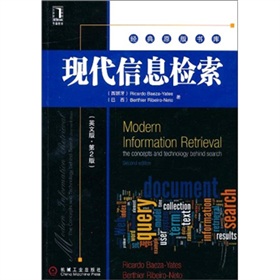现代信息检索 电子书下载 PDF下载

内容简介
《现代信息检索》详细介绍了信息检索的所有主要概念和技术,以及有关信息检索方面的所有新变化,使读者既可以对现代信息检索有一个全面的了解,又可以获取现代信息检索所有关键主题的详细知识。《现代信息融合技术在组合导航中的应用》的主要内容由信息检索领域的代表人物Baeza-Yares和]Ribeiro-Neto编著,对于那些希望深入研究关键领域的读者,书中还提供了由其他主要研究人员编写的关于特殊主题的发展现状。与上一版相比,本版在内容和结构上都有大量调整、更新和充实,其中新增内容在60%到70%左右。具体更新情况如下新增了文本分类、网络信息爬取、结构化文本检索和企业搜索等章节,以及关于开源搜索的一个附录。全面改写了用户界面、多媒体检索和数字图书馆等内容。拓展了一些章节,介绍了信息检索方面的新的重要进展,如语言模型、新的评价方法、查询的特点、基于聚类和分布式信息检索等。
·查看全部>>
目录
Preface to the Second Edition
Preface to the First Edition
Authors' Acknowledgements to the Second Edition
Authors' Acknowledgements to the First Edition
Publishers' Acknowledgements
1 Introduction
1.1 Information Retrieval
1.1.1 Early Developments
1.1.2 Information Retrieval in Libraries and Digital Libraries
1.1.3 IR at the Center of the Stage
1.2 The IR Problem
1.2.1 The User's Task
1.2.2 Information versus Data Retrieval
1.3 The IR System
1.3.1 Software Architecture of the IR System
1.3.2 The Retrieval and Ranking Processes
1.4 The Web
1.4.1 A Brief History
1.4.2 The e-Publishing Era
1.4.3 How the Web Changed Search
1.4.4 Practical Issues on the Web
1.5 Organization of the Book
1.5.1 Focus of the Book
1.5.2 Book Contents
1.6 The Book Web Site: A Teaching Resource
1.7 Bibliographic Discussion
User Interfaces for Search
by Marti Hearst
2.1 Introduction
2.2 How People Search
2.2.1 Information Lookup versus Exploratory Search
2.2.2 Classic versus Dynamic Model of Information Seeking .
2.2.3 Navigation versus Search
2.2.4 Observations cf the Search Process
2.3 Search Interfaces Today
2.3.1 Getting Started
2.3.2 Query Specification
2.3.3 Query Specification Interfaces
2.3.4 Retrieval Results Display
2.3.5 Query Reformulation
2.3.6 Organizing Search Results
2.4 Visualization in Search Interfaces
2.4.1 Visualizing Bcolesn Syntax
2.4.2 Visualizing Query Terms within Retrieval Results
2.4.3 Visualizing Relationships Among Words and Documents
2.4.4 Visualization for Text Mining
2.5 Design and Evaluation of Search Interfaces
2.6 Trends and Research Issues
2.7 Bibliographic Discussion
Modeling
3.1 IR Models
3.1.1 Modeling and Rankirg
3.1.2 Characterization cf an IR Model
3.1.3 A Taxonomy of IR Models
3.2 Classic Information Retrieval
3.2.1 Basic Concepts
3.2.2 The Boolean Model
3.2.3 Term Weighting
3.2A TF-IDF Weights
3.2.5 Document Length Normalization
3.2.6 The Vector Model
3.2.7 The Probabilistic Mcdel
3.2.8 Brief Comparison of Classic Models
3.3 Alternative Set Theoretic Models
3.3.1 Set-Based Model
3.3.2 Extended Boolean Model
3.3.3 Fuzzy Set Model
3.4 Alternative Algebraic Models
3.4.1 Generalized Vector Space Model
3.4.2 Latent Semantic Indexing Moo'el
3.4.3 Neural Netwozk Model
3.5 Alternative Probabilistic Mcdels
3.5.1 BM25
3.5.2 Language Models
3.5.3 Divergence from Randomness
3.5.4 Bayesian Network Models
3.6 Other Models
……
4 Retrieval Evaluation
5 Relevance Feedback and Query Expansion
6 Documents:Languages &Properties
7 Queries:Languages &Properties
8 Text Classiftcation
9 Indexiong and Searching
10 Parallel and Distributed IR
11 Web Retrieval
12 Web Crawling
13 Structured Text Retrieval
14 Multimedia Information retrieval
15 Enterprise Search
16 Library Systems
17 Digital Libraries
Preface to the First Edition
Authors' Acknowledgements to the Second Edition
Authors' Acknowledgements to the First Edition
Publishers' Acknowledgements
1 Introduction
1.1 Information Retrieval
1.1.1 Early Developments
1.1.2 Information Retrieval in Libraries and Digital Libraries
1.1.3 IR at the Center of the Stage
1.2 The IR Problem
1.2.1 The User's Task
1.2.2 Information versus Data Retrieval
1.3 The IR System
1.3.1 Software Architecture of the IR System
1.3.2 The Retrieval and Ranking Processes
1.4 The Web
1.4.1 A Brief History
1.4.2 The e-Publishing Era
1.4.3 How the Web Changed Search
1.4.4 Practical Issues on the Web
1.5 Organization of the Book
1.5.1 Focus of the Book
1.5.2 Book Contents
1.6 The Book Web Site: A Teaching Resource
1.7 Bibliographic Discussion
User Interfaces for Search
by Marti Hearst
2.1 Introduction
2.2 How People Search
2.2.1 Information Lookup versus Exploratory Search
2.2.2 Classic versus Dynamic Model of Information Seeking .
2.2.3 Navigation versus Search
2.2.4 Observations cf the Search Process
2.3 Search Interfaces Today
2.3.1 Getting Started
2.3.2 Query Specification
2.3.3 Query Specification Interfaces
2.3.4 Retrieval Results Display
2.3.5 Query Reformulation
2.3.6 Organizing Search Results
2.4 Visualization in Search Interfaces
2.4.1 Visualizing Bcolesn Syntax
2.4.2 Visualizing Query Terms within Retrieval Results
2.4.3 Visualizing Relationships Among Words and Documents
2.4.4 Visualization for Text Mining
2.5 Design and Evaluation of Search Interfaces
2.6 Trends and Research Issues
2.7 Bibliographic Discussion
Modeling
3.1 IR Models
3.1.1 Modeling and Rankirg
3.1.2 Characterization cf an IR Model
3.1.3 A Taxonomy of IR Models
3.2 Classic Information Retrieval
3.2.1 Basic Concepts
3.2.2 The Boolean Model
3.2.3 Term Weighting
3.2A TF-IDF Weights
3.2.5 Document Length Normalization
3.2.6 The Vector Model
3.2.7 The Probabilistic Mcdel
3.2.8 Brief Comparison of Classic Models
3.3 Alternative Set Theoretic Models
3.3.1 Set-Based Model
3.3.2 Extended Boolean Model
3.3.3 Fuzzy Set Model
3.4 Alternative Algebraic Models
3.4.1 Generalized Vector Space Model
3.4.2 Latent Semantic Indexing Moo'el
3.4.3 Neural Netwozk Model
3.5 Alternative Probabilistic Mcdels
3.5.1 BM25
3.5.2 Language Models
3.5.3 Divergence from Randomness
3.5.4 Bayesian Network Models
3.6 Other Models
……
4 Retrieval Evaluation
5 Relevance Feedback and Query Expansion
6 Documents:Languages &Properties
7 Queries:Languages &Properties
8 Text Classiftcation
9 Indexiong and Searching
10 Parallel and Distributed IR
11 Web Retrieval
12 Web Crawling
13 Structured Text Retrieval
14 Multimedia Information retrieval
15 Enterprise Search
16 Library Systems
17 Digital Libraries
同类热门电子书下载更多
- 知识管理:企业档案信息化战略之选
- 财经新闻系列教程:财经新闻经典报道选读
- 微博赢销:140字改变全球
- 传播网络理论
- 网络口碑的形成、传播与影响机制研究
- 21世纪新闻传播学研究生系列教材:新闻专业主义研究
- 对外汉语教学专业教材:跨文化交际与第二语言教学
- 人际传播教程
- 媒体话语权:美国媒体如何影响世界
- 媒介理论前瞻
- 新闻与传播系列教材·媒介化政治:政治传播新论
- 现代信息检索
- 高等学校信息管理学专业系列教材:《信息管理学基础》案例与实验教程
- 传播学批判研究:美国的传播、历史和理论
- 传播学通用教程
- 信息时代的媒介素养
- 新闻与传播学译丛·国外经典教材系列:传播理论导引
- 中国国家形象:全球传播时代建构主义的解读
- 20世纪传播学经典文本
- 舆情蓝皮书:中国社会舆情与危机管理报告
Copyright © 2025 by topbester.com.
All Rights Reserved.
沪ICP备14027842号-1
All Rights Reserved.
沪ICP备14027842号-1